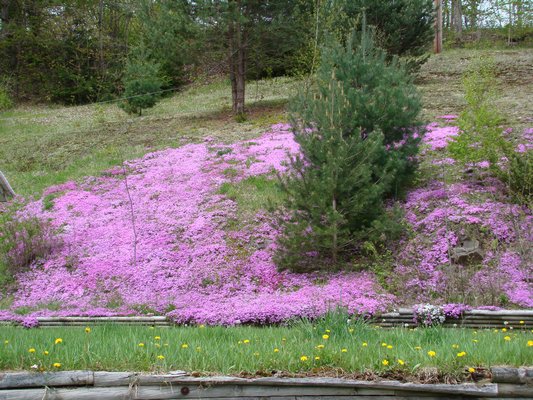

I’m often plagued by a song that gets stuck in my mind.I’ll hear it all day, wake up hearing it and just can’t seem to shake it until my mind gets bored with it. But several days ago someone asked me a plant question and for three days I haven’t been able to get it out of my mind. The question was simple enough. A friend said, “You know about things like this. My wife wants to plant a groundcover on a slope behind the house. What can she use?”
I asked a few more questions and found out that she grows some heather on the slope and didn’t want it crowded, and that there was shade to the sides of the area and “pretty good” soil. So for three days my mind began a list that grew longer and longer and longer. Then I realized I actually had no idea what she had in her mind when she imagined a groundcover. And then again my mind started making a list of short, tall, creeping, evergreen, scented, flowering—and it went on and on and on.
So, if you’re considering a groundcover and don’t have a clue what to use, it’s probably a good idea to organize your thoughts into several categories and then dive in. If you dive in first, you’ll drown in possibilities only to find that most of them aren’t appropriate for your particular situation. First, analyze the site. Is it flat, sloped or actually hilly? What’s the exposure like? Does it get sun all day or just part or parts of the day? Watch the sun for a few days and see how it lights the area and when. But also keep in mind that the sun’s angle is now near its apex, and at other times of the year—say earlier in the spring or late in the summer—the lighting may be very different. The plant’s light needs don’t change with the angle of the sun.
Are there rocks in the area you want to plant? Will you want your groundcover to encircle the rocks or other features, or do you want your groundcover to be controlled and managed as opposed to all consuming? What’s the soil like? Sandy soil can be an opportunity or a curse, but one good thing about sandy soil is that it can be amended and changed. Is there water nearby so you can irrigate your groundcover until it gets established? And of course, will mulch do, instead of live plants?
Do you want an edible groundcover? Ah, you never thought about that did you? Do you want your groundcover to flower and what color should the flowers be? Will a natural and native groundcover like Lycopodium do the trick? What color should the groundcover be? Can it be green, a yellow-green, emerald green, gray, variegated? Is the area subject to salt spray from the bay, ocean or a salt spreader flying by on a cold and icy winter day?
A few things to consider, yes?
One of my favorite groundcovers is thyme. As I drive through the country roads of upstate Ulster and Delaware counties in mid-summer, I can see properties that would make you cry if you love thyme. It’s a native plant up there and the shallow, fast-draining soils are perfect for this plant and it often covers acres at a time. Not because it was planted, but because it’s native and oh, so very happy. But when I plant it in my garden—trying to establish it between the rocks that make up the garden path—it grows for one summer, emerges in spots the second summer, then it’s gone. My problem is shade, and soil that’s too rich. But Irish moss or Salogenela subulata just loves the damp pavers and dappled shade, so it’s moved in as the groundcover that does well—in that particular spot.
Another perennial that does really well among rocks, on slopes or as mass plantings is Phlox subulata, also known as the creeping phlox. It can be planted between slate or stone pavers as long as the planting area is at least six or more inches wide. It loves hanging over stone walls, though the newer varieties have been cultivated for compactness and not the ability to sprawl—so be careful of the variety you choose. Colors are pink, white and blue, though some claim to be red and there are even bicolors that I think are horrendous. I’ve been known to visit a cemetery that goes back to the late 19th century and the Phlox subulata that was planted between the graves still remains, and when in flower it’s quite a sight.
Deer will graze on this plant. If they don’t, you should—with sheers. When cut back early in the summer it causes each branch to further branch and results in even more flowers the following year. Once established it needs no care and with the right amount of light and an annual trim it does really well.
But you didn’t tell me how tall you want your groundcover. There is no rule, by the way, and tallish plants can cover the ground quite well. A favorite in this category is Polygonatum odoratum pictum, or dwarf false Solomon’s seal. This plant spreads naturally via its rhizomatous roots, but it’s by no means invasive. A 4-square-foot planting can be divided and doubled every year. Unless you contain it, the plant will slowly but surely continue to expand its range. The stems or stalks are 12 to 15 inches tall and slightly arching with bell-like white flowers in May. The foliage is green with a white edge, though if the plant doesn’t get enough light it will just be green and thus lose half its appeal. It can be planted under and among shrubs like rhododendrons and azaleas, where it will hide the shrubs’ bare stems, or left to grow at the edge of the woods.
The there’s Sweet Woodruff or Galium odoratum. Want a quick fill in that grows to about 6 inches tall and will cover everything in its path? Then this is the plant for you. But beware, it is fast growing and once established it spreads and spreads. It’s got nice white flowers in the spring and the plant itself is pretty hardy, but it can become a pest not unlike Aegopodium (bishop’s weed).
And there are the two stalwarts of the groundcover world, Vinca minor and Pachysandra. Both have their detractors, but both are hardy and reliable plants as long as you use them wisely. Vinca minor does great in sun to partial sun but it will thin out quickly as you increase the shade. It has star-shaped blue flowers for most of the season and it can be sheared with a hedge clipper to keep it neat and managed. A variegated type had a white edge on the leaves but it’s not as vigorous as the solid green species.
Pachysandra has gotten a bad rap. It is not invasive, as once thought. While it does have a disease or two, it tolerates sun to shade and can become quite dense. It’s easy to plant and care for but will not appreciate constant overhead irrigation from a watering system that doesn’t know when the soil is too wet.
For shrub lovers, don’t overlook the creeping junipers, or Juniperus horizontalis. Slow growing but quite attractive, this evergreen is available in a number of colors including green, blue and a slightly yellow type. It can be damaged by excessive salt spray and flooding, but the green varieties seem somewhat salt tolerant. Blue rug is one of the most popular.
There are many, many other possibilities. There are prostrate blueberries, cranberries, winterberry, sedums, shorter types of Japanese painted ferns and a host of Lamiums with colorful foliage and flowers. And then there are the walkables. But, another time. Keep growing.
 More Posts from Andrew Messinger
More Posts from Andrew Messinger